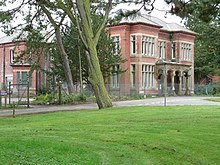Whittingham Hospital
| Whittingham Hospital | |
|---|---|

The main building entrance (St Luke's Division) in 2008
|
|
|
Shown in the City of Preston district
|
|
| Geography | |
| Location | Whittingham, Lancashire, England |
| Coordinates | 53°49′01″N 2°39′29″W / 53.817°N 2.658°WCoordinates: 53°49′01″N 2°39′29″W / 53.817°N 2.658°W |
| Organisation | |
| Care system | NHS |
| Funding | Public hospital |
| Hospital type | Specialist |
| Services | |
| Emergency department | No |
| Helipad | No |
| Beds | 3533 in 1939 |
| Speciality | Psychiatric hospital |
| History | |
| Founded | 1 April 1873 |
| Closed | 1995 |
Whittingham Hospital was a psychiatric hospital in the parish of Whittingham, near Preston, Lancashire, England.
The hospital opened in 1873 as the Fourth Lancashire County Asylum and grew to be the largest mental hospital in Britain, and pioneered the use of electroencephalograms (EEGs). During its time it had its own church, farms, railway, telephone exchange, post office, reservoirs, gas works, brewery, orchestra, brass band, ballroom and butchers. It closed in 1995.
In 1866, the three Lancashire lunatic asylums at Prestwich, Rainhill and Lancaster were deemed to be full. Extra accommodation was urgently needed and to this end the building of Whittingham Asylum "for pauper lunatics" began in 1869. The hospital was designed by Henry Littler of Manchester, Architect to the Lancashire Asylums Board and built of red brick made from clay dug on site. The buildings followed a plan of multiple quadrangles with inter-connecting corridors radiating from a long axial corridor section.
The hospital officially opened on 1 April 1873, although 115 patients had already been admitted in the previous year, some of whom helped with the building work. The large complex (to be known as St. Luke's Division from 1958) was completed in June 1875, and had an initial capacity of 1100 inmates and included an Anglican church, a Catholic chapel, a recreation hall and a large farm estate.
In 1878 a new annexe (known as St. John's Division from 1958) was built on 68 acres of land to the north of the site. The annexe was completed in 1880 and could accommodate 700 patients and, by the special agreement of the Postmaster General, the hospital's own dedicated Post Office. The hospital contributed £15,500 towards Fulwood Urban District Council's scheme to extract water from Beacon Fell, in exchange for 90,000 gallons of water per day to be supplied, free of charge, to the hospital. This was achieved under the Fulwood and Whittingham Water Act of 1882. In 1884, a sanatorium was established in the grounds for patients with infectious diseases.
...
Wikipedia

